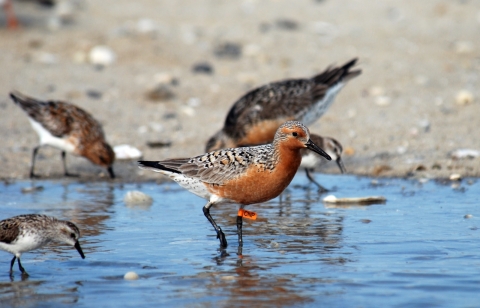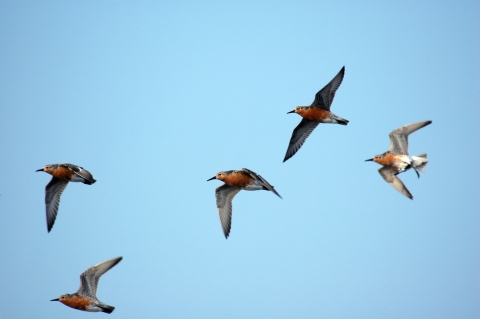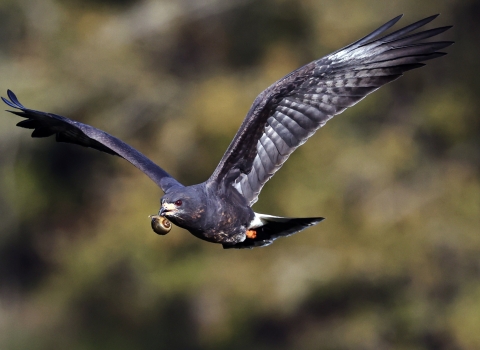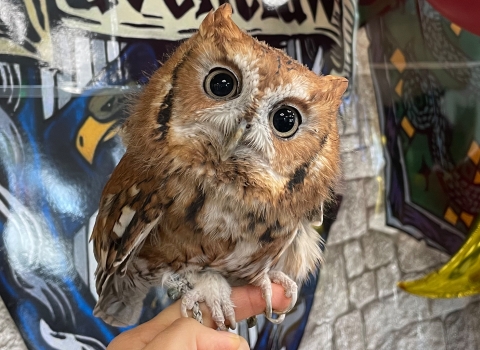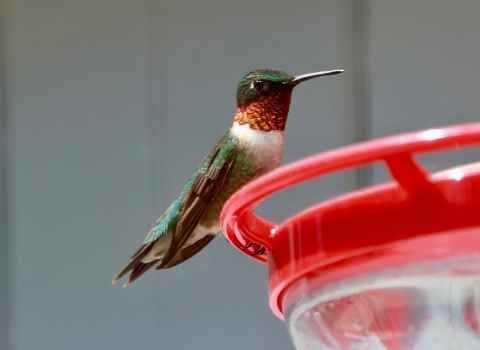Found on all continents except Antarctica, red knots are likely the world’s most cosmopolitan traveling shorebird.
The rufa subspecies occurs along the Atlantic and Gulf Coasts of the Western Hemisphere with some traveling almost 19,000 miles annually between their breeding grounds in the Arctic of Central Canada and wintering grounds as far away as Tierra del Fuego at the southern tip of South America. The roselaari subspecies occurs on the west coast of North America, migrating from the Arctic breeding grounds in Alaska to wintering locations in Mexico.
Description
Red knots are plump, six to eleven-inch sandpipers. During nesting season their upper body is a combination of reddish-brown, gold, buff, and black colors with terracotta orange underparts. During winter their plumage is grey on the back and head and a white breast and belly with juvenile birds having similar appearance plumage. Their eyes, beak and legs are black, and they have a 20-inch wingspan.
Migration Stopovers within the United States
Spring migration stopover sites in the Southeast exist in Florida, Georgia, South Carolina, and North Carolina. Other spring stopover sites to the north include the Virginia barrier islands and Delaware Bay (Delaware and New Jersey) as well as the Nelson River Delta in Hudson Bay.
Major fall stopover sites in Canada include southwest Hudson Bay (including the Nelson River delta), James Bay, and the Mingan Archipelago in Canada, Cape Cod in Massachusetts, and the mouth of the Altamaha River in Georgia in the US.
Florida is unique in that it is hosts red knots year-round being home to spring and fall migratory birds, wintering birds, as well as juvenile birds that reside there all year long.
Where to Find Red Knots:
- Cape Romain National Wildlife Refuge, South Carolina: A rich mosaic of barrier islands with forest and ponds, vast salt marshes and intricate waterways. This diverse and dynamic system supports over 293 bird species and a myriad of other wildlife.
- St. Vincent National Wildlife Refuge, Florida: This refuge is an important stop-over point along the Gulf coast for neotropical migratory birds and a haven for threatened and endangered species.
- Cedar Keys National Wildlife Refuge, Florida: This refuge provides a safe haven for wildlife and terrific recreation opportunities for people in the Gulf of Mexico.
- Merritt Island National Wildlife Refuge, Florida: This refuge is strategically located on the Atlantic Flyway, a major bird migration corridor, and it is a key resting stop for many migratory bird species.
Fun Facts About Red Knots
Red knots feast primarily on small bivalves along with, shrimp, crabs, and marine worms. Before taking off on their long migrations, red knots can gorge themselves with food to fuel their journey. During migration, their metabolic rates also change, and their leg muscles, gizzard, stomach, intestines, and liver all decrease in size, while the pectoral muscles and heart increase in size. Due to these physiological changes, red knots arriving from lengthy migrations can only feed on soft prey such as horseshoe crab eggs. In these areas, they will arrive emaciated and can double their weight for their next leg in as little as 10 days!
Horseshoe crab eggs from superabundant spawning populations of horseshoe crabs are the most important food for red knots during spring migration. These concentrations can be found on the beaches of Delaware Bay and the Coast of Georgia and South Carolina. Red knots gather in huge groups at these traditional stopovers to fuel up for their final 1,500-to-2,000-mile flight to the Arctic. As much as 30 percent of the population are even flying to the Arctic straight from the Southeast (South Carolina, Georgia, and Florida)!
Migrating and wintering red knots are seen in marine habitats, such as sandy beaches, saltmarshes, lagoons, mudflats of estuaries and bays, and mangrove swamps.
The red knot is federally listed as threatened. The red knot faces several challenges including the warming climate of the Arctic, which is the only place red knots breed. Horseshoe crabs from Delaware Bay remain a very important food source for red knots during their migration. Better management has stabilized populations of this main food source a true conservation success story! Red knots also compete for space on beaches along their migration for feeding and resting as beaches are developed and easily accessed, which increases human recreation opportunities.
- The oldest known red knot in North America was over 22 years old having hatched in 1992 and last seen in 2014. It was nicknamed “Moonbird” as all of those many migrations would’ve been equivalent to traveling the distance to the moon and partially back as it was known to winter in Tierra del Fuego.
What You Can Do!
Red knots are of the most studied shorebird in North America with a robust marking program using field-readable coded leg flags that are light or dark green in color. If you see one of these special birds, please record its code and when, where you saw it and, if possible, flock size and report it here. Remember to maintain your distance and not disturb feeding and roosting flocks! Dogs (on leash or off leash) are extremely disruptive to red knots and other shorebirds. Please do not take your dog to areas essential to shorebirds such as areas around inlets.
Red Knot Photo Contest
As part of our Bird of the Month series, we invite you to submit your photos of red knots in a photo contest.
**In the file name of your photo, please include your first and last name, contact email address, and the location where the photo was taken. If these components are missing, we will have no way of contacting you if you win.**
Submissions will be judged by a panel of U.S. Fish and Wildlife Service employees. Once a winner is selected, they will be contacted via email and asked to sign a photo release form. This form protects the photographer's rights, ensures proper credits are given, and grants the U.S. Fish and Wildlife Service permission to share the photo on our social media channels. Please monitor your junk/spam folders towards the end of the month if we reach out and our e-mail lands there.
The winner will be announced publicly near the end of each month on our Southeast Regional Facebook and X (formerly known as Twitter) platforms.
A photo contest will occur each month for each featured bird species. At the end of 2024, all twelve winning photographs will be shared on our regional social media accounts.



